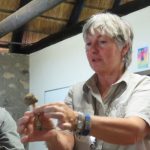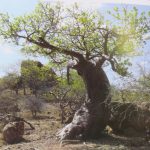TREE LIFE
MARCH 2022
PARADISE IN THE HILLS
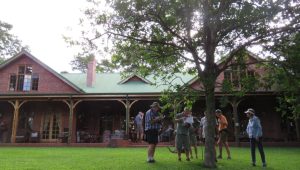
.
Tea in front of the lovely homestead. Photo: Rob Jarvis
Hi Everyone,
We were very pleased to be able to visit the home of Karl van Laeren out in Greystone Park, overlooking the Brookfield Valley. Karl and Annelie were tremendous hosts and the parking was shady, the route through the miombo woodland well-chosen and relatively easy to follow without anyone taking any serious tumbles and of course the trees were a treasure. Karl had done his homework and was able to show us choice specimens along the way and he could recount what each tree was and if introduced, where it had come from and why he had planted it in its current position. The afternoon was made perfect by a relaxing tea on the verandah of a stunningly built house that was literally custom-designed for the setting. In the picture above we see avid botanists surround a tree that had been saved on the front lawn. The rest of the property consisted of recovering miombo woodland that had been cut down some years ago and is now regrowing. Interspersed among the munondo, musasa and Uapaca originally-dominant trees were many others. Of particular interest was the natural phasing out of the Uapaca sections of the woodland as the miombo trees gain traction. Annelie showed us some of the exquisite glasswork she does in a workshop on site. Incredible work!
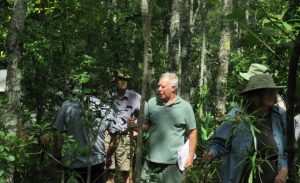
Karl showing the tremendous growth of the trees. Photo: Rob Jarvis
The host Karl, spotlighted in the forest on the right explained how the woodland was literally just young saplings when they first moved into the property and now it provides a dense shadowy world where the bulk of the 20-odd Tree Society members attending, could hide incognito.
Below we see the fluted bark of erythrina, almost like cork oak,
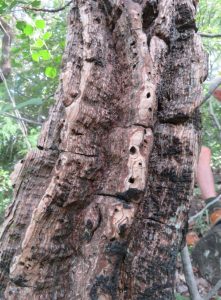
Fluted bark of Erythrina, almost like a cork oak. Photo: Rob Jarvis
And below we see a golden orb spider photographed with a munondo (Julbernardia globiflora) trunk immediately behind.
The woodland was densely occupied by these spiders weaving their webs between the trees. Gracing some scrambling Bauhinia tomentosa were their bright yellow flowers.
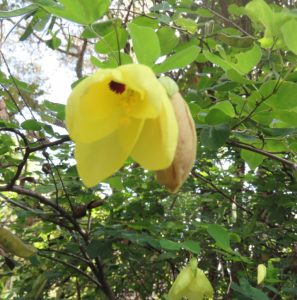
Bauhinia tomentosa flowers Photo: Rob Jarvis
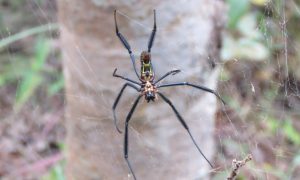
A golden orb spider photographed with a munondo (Julbernardia globiflora) trunk Photo: Rob Jarvis
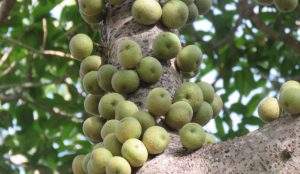
Ficus sansibarica that Karl had planted over the site of the soakaway used by the building crew during operations Photo: Rob Jarvis
An unusual tree seen towards the end of our walk was this Ficus sansibarica that Karl had planted over the site of the soakaway used by the building crew during operations. Covered as you can see with highly nutritious fruit. The tree does occur in a long strip of country coming from the Zambezi Valley near Binga on Lake Kariba and flowing through into northern Limpopo province in South Africa. Other natural pockets are north of Harare and in the Eastern Districts south of Mutare. There will definitely be a feast to be had by all manner of primates, bats and birds when these figs ripen.
As we went further down the property to some rocky outcrops there was a much wider range of trees to be seen and most of them fairly young or maybe stunted due to the underlying rock. Seen were Sterculia rogersii and S. quinqueloba, Stereospermum kunthianum, (pink jacaranda) Securidaca longipedunculata (violet tree), Dichrostachys cinerea (sickle bush or Chinese lanterns).
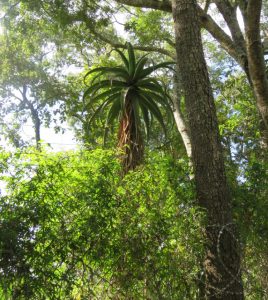
Aloe excelsa, standing tall and proud in the woodland understorey. Photo: Rob Jarvis
And just over the fence in the neighbouring property was a magnificent specimen of Aloe excelsa, standing tall and proud in the woodland understorey.
Other trees seen on the walk included Commiphora schimperi, Ekebergia benguelensis, Anthocleista, Combretum molle, Vangueria, Tabernaemontana elegans, (toad tree) Grewia, Euphorbia ingens, Steganotaenia araliacea, (carrot tree), Pittosporum viridiflorum, (cheesewood), Dais cotinifolia, Celtis africana, (white stinkwood) Khaya anthotheca, (red mahogany), Bridelia micrantha, Hymenodictyon floribundum (flame bush), Bolusanthus speciosus, (tree wisteria), Acokanthera oppositifolia (Bushman’s poison) were all trees we saw.
BOTANIC GARDEN WALK SATURDAY 5TH FEBRUARY 2022
Our first walk in the Gardens in 2022. In January we were rained off.
The weather report predicted rain but we had a beautiful morning. Sadly only a few stalwarts were there to enjoy the outing. Tony, Jan, Mark, Teig, Jim and Ann.
We started up the steps and noted the distinctive wing pods on Xeroderris stuhlmannii, but also that there were very few pods. It is interesting to note how trees differ from year to year. Sometimes producing a mass of pods and in others very few. Does this depend on the season?
Has there been a lot of rain or very little?
We turned right toward the dam, the Berchemia discolor, bird plum was full of green fruit, and Bauhinia petersiana the white Bauhinia was in flower with long crinkly white petals. Cassia abbreviata with its long pods, now green before turning dark brown.
We all gasped as we came in site of the dam. It was half full of water, a wonderful sight after years of seeing a very sad dry empty hole. It has been relined with plastic and filled with the recent rain.
On the edge of the dam we looked at a Grewia flavescens, It has square stems, yellow flowers and the fruit is usually 2-lobed, occasionally single or 4-lobed, commonly referred to as the Donkey berry.
Heading back towards the West side a Teclea nobilis, which grows in riverine and evergreen forest, the leaves are trifoliate narrowly elliptic, aromatic when crushed with a citrus aroma.
An alien Solanum spafurthiana a creeper which was introduced with horse feed and has orange tentacles. Plenty of Lantana camara. I remember as a child, 70 years ago, all Post Offices had posters of Lantana camara and Witch weed. Labeling them noxious weeds and anyone found with them growing on their properties would be fined.
Pistachio chinensis from China.
Pavetta gardeniifolia full of fruit.
Diospyros senensis, the Peeling bark diospyros, with a smooth cream underbark. Multi-stemmed from the base. Fruit ovoid with a persistent calyx, characteristic of Diospyros species.
Friesodielsia obovata, monkey fingers, referring to the fruit which turns red when ripe and consists of 3 to 9 monocarps, fingers. The fruit is edible and fleshy.
Bauhinia tomentosa, there were lots of shrubs with attractive bell shaped flowers with large yellow petals, most of which have a dark maroon patch at the base. The fruit is a velvety brown pod.
Albizia anthelmintica, so named as the bark is used as an anthelmintic against tape worms.
Feretia aeruginescens a lowveld tree or shrub.
Baikiaea plurijuga, the Zimbabwe teak tree was full of buds, it will be a real sight in a week or two. The flowers are in auxiliary racemes up to 30 cams long. The buds are golden brown and velvety. The flowers are a pinkish mauve and crinkly.
Terminalia brachystemma a Kalahari sand Terminalia. The leaves are crowded at the end of the branches and have no petioles. The fruit is 5 to 3.5 cms, almost round with an almost circular wing. Bright crimson when mature drying to a reddish purplish brown.
Commiphora mollis with a peeling green bark.
Ziziphus Sp. In flower, we decided it must be pollinated by flies as there were plenty crawling among the flowers.
Excoecaria bussei the pawnbroker’s tree looking very earthy with masses of green fruit. This dries to a pale brown. The fruit has three brown round seeds.
Bridelia mollis the velvet Bridelia with soft hairy leaves.
The last tree we looked at was the Ormocarpum zambesianum
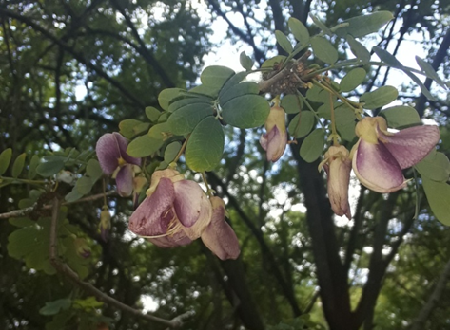
Ormocarpum zambesianum flowers – photo by Tony Alegria
Thank you to Tony and Mark for guiding and informing us. A fascinating morning.
–Ann Sinclair
Next month will be the 500th issue of Tree Life, the Newsletter of the society We hope to make it a bumper edition and centred upon the baobab, which is the largest tree by girth found in Zimbabwe and many of the biggest ones will probably vastly exceed 500 years in age.
This Month there will be an outing to St George’s College Sunday 20th March.
This month there will be an outing to St Georges College on the Borrowdale Road where we shall team up with the College’s own Tree Society and take a look at some of the trees they have on campus. It should be a great day as there is an excellent, very large rockery on the right as you drive up towards the Chapel which has many different species of trees and succulent and waterwise plants. This will be the normal third Sunday of the month outing for the Society and details will follow on WhatsApp and by e-mail nearer the time. Be sure to some along.
A TRIBUTE TO FALLEN TREES
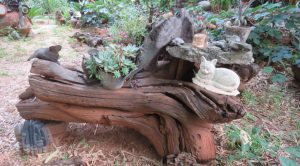
Stumps, driftwood logs, wood roses, finely-grained planks and various bits of wood that have either been crafted by an artist into a new object or fashioned by Nature Photo: Rob Jarvis by Rob Jarvis
I am sure that many of you have collected stumps, driftwood logs, wood roses, finely-grained planks and various bits of wood that have either been crafted by an artist into a new object or fashioned by Nature and using the innate skills of pareidolia that we all have to some extent, whereby we see something different in the clouds, trees or in this case, the piece of wood. My own interest in indigenous trees was originally sparked by a magnificent specimen of the tree wisteria, Bolusanthus speciosus, which once grew on the left hand side of the road just after you cross the Serui River about halfway from Harare to Kadoma. For nearly a decade I had watched this tree, amazed at its girth for its species and we would always be enthralled when the tree flowered in spring. Similar in many ways to jacarandas which also herald spring with their purple flowers, but the tree wisteria is somehow more whimsical, the leaves and flowers appear almost simultaneously. Well unfortunately for the tree it was growing under the telephone landlines and the PTC came along one day and chopped every tree growing below their lines. Imagine our shock when we found our favourite tree had been felled and left ignominiously lying in the undergrowth. They had even dug the stem and roots out of the ground to prevent regrowth. Well eventually we found a means to get the stump and the main stems brought back to our house, then in Kadoma and we have kept the stump ever since and had it fashioned by one of the Zata brothers into a garden bench. Tree wisteria wood is one of the finest woods you can find, it doesn’t rot, termites cannot touch it and it saws and planes very smoothly. The stems we cut into cross-sections and used them on a bar-top for a while and now they are stored in a container awaiting final positioning.
Of course the King of Memorabilia of fallen trees is a chunk of fossilised wood. I know we once found a large log just lying in the bush just after the turn-off to Sanyati from Golden Valley near Kadoma. We raced back to the farm where we were based, grabbed a pick-up and several labourers and sped back to pick it up and spent hours washing it off and out. You can see where the knots were in the wood, where hollow channels went right through the heart of the stump and applying the hosepipe at one end saw water pouring out the far end. It is silica-laden and obviously has no wood at all now and is incredibly heavy.
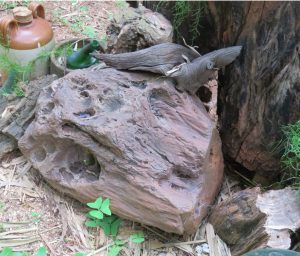
A chunk of fossilised wood. Rob Jarvis
This piece of fossilised wood still has pride of place in our garden treasures and undoubtedly it had been abandoned there by some other collector who for one reason or other had to toss it off his own pick-up. Certainly there are no other known fossilized forests anywhere near Golden Valley. Scientists have given species names to fossilised trees but we have no idea what ours is. Just to the right of the prized log in the picture left you can see a piece of a cross-sectioned log and the annual growth rings are clearly visible in the silica rings that have replaced the original woody tissue. Quite amazing that a tree that was growing in its prime maybe 400 million years ago can be remembered today by these indelible fingerprints.
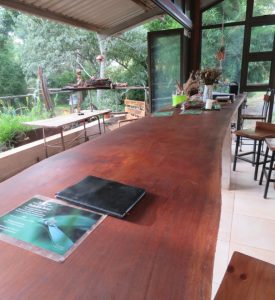
Khaya anthotheca which now is the dominant feature in the retirement house we recently built. Photo: Rob Jarvis
When Giants fall it is well that they are remembered. In my teens I spent six years at a high school in what is now Mutare and we often parked our bicycles under the shade of a huge red mahogany. Khaya anthotheca as you all know can make towering specimens and this particular tree was no exception. Unfortunately they have a habit of self pruning and at the most unexpected and inconvenient of times they send huge branches crashing to the ground and if your home, car or family member happens to be underneath at the time, the consequences are tragic. The school had no option but to cut this magnificent tree down and luckily in Mutare the Goss family specialise in sawing such timber into huge planks suitable for bar counters, table tops and the like, mainly for safari camps. We pleaded with them to allow us to purchase the plank seen left which now is the dominant feature in the retirement house we recently built. Beautiful wood in a wonderful setting.
And of course on special occasions the nuclear family can sit around the same table. It is of relatively minor importance that the whole house had to be redesigned to fit the plank and a glass and aluminium sliding door now allows access to an outside deck, the roof is extended and the area is a fine entertainment area where we successfully run our Chameleon Safari operation!
Below we see some examples of collected items of wood that we have just chanced upon along the way. On the bottom left is a log we found buried deep in the mud in a gravel pit at the Cotton Research Institute in Kadoma. Undoubtedly it was from a eucalypt that was cut down to make way for arable lands at some stage. Embedded in red mud it had probably started its own cycle of fossilisation, but we couldn’t afford to wait the 400 million years to complete the process so we dug it out, cleaned it off and it now has accompanied our very move since 1975! When taking the photograph I found that a random sapling of the pink cedar, or Kenya coffee shade tree (Acrocarpus) had taken root in one of the cracks on its surface. That will have to be dealt with otherwise our new house will be threatened with yet another tree renowned for self-pruning, ground-quaking branches.
Below right we see a piece of driftwood that prompted the pareidoloia genes to kick in. I had no doubt in my mind that this driftwood, recovered from a sandbank on the Lower Zambezi near Kanyemba was without doubt, a duck in a former life.
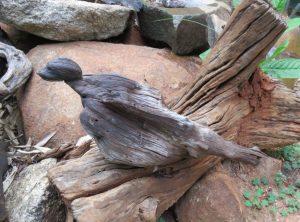
Recovered from a sandbank on the Lower Zambezi near Kanyemba was without doubt, a duck in a former life. Photo: Rob Jarvis
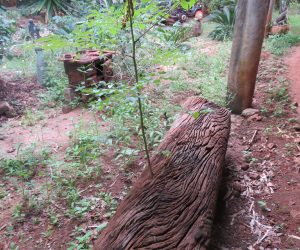
A log we found buried deep in the mud in a gravel pit at the Cotton Research Institute in Kadoma. Photo: Rob Jarvis
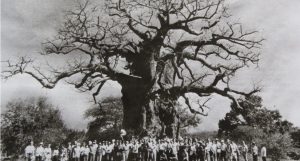
Group gathered around a spectacular baobab. Next issue devoted to baobabs
And so I am sure many of you have similar treasures of former forests or trees that you can relate fascinating stories about how you found them, where they came from and how you use them in the garden today. I know that the fluctuating shorelines of Lake Kariba used to have millions of mopane stumps (Colophospermum mopane). I know that it is very much frowned upon to remove such things from our National Parks Estates but the alternative is to find them gone with the only evidence that they once existed, a pile of charcoal on the banks of the lake.
It is quite shocking these days to revisit parts of the lakeshore that are frequented by houseboats, kapenta or even illegal netters and where once we thought there was an inexhaustible supply of dead wood, today there is almost nothing left
So before you forget, before the dreaded Altzeihemers, Parkinsons or similar afflictions take your grey cells down, write a story about your treasures and submit it for inclusion in Tree Life. The trees deserve to be remembered, even if you cannot!
CHAIRMAN TONY ALEGRIA


